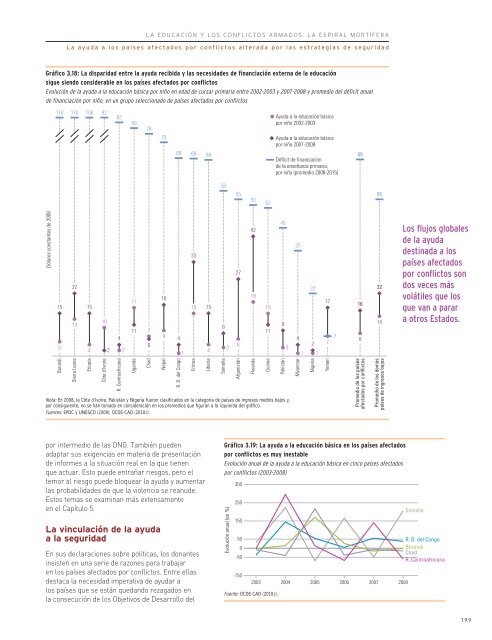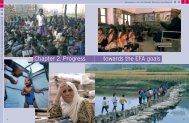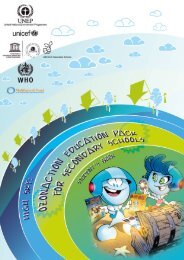Capítulo 3 La educación y los conflictos armados: la espiral mortífera
Capítulo 3 La educación y los conflictos armados: la espiral mortífera
Capítulo 3 La educación y los conflictos armados: la espiral mortífera
You also want an ePaper? Increase the reach of your titles
YUMPU automatically turns print PDFs into web optimized ePapers that Google loves.
LA EDUCACIÓN Y LOS CONFLICTOS ARMADOS: LA ESPIRAL MORTÍFERA<br />
<strong>La</strong> ayuda a <strong>los</strong> países afectados por <strong>conflictos</strong> alterada por <strong>la</strong>s estrategias de seguridad<br />
Gráfico 3.18: <strong>La</strong> disparidad entre <strong>la</strong> ayuda recibida y <strong>la</strong>s necesidades de financiación externa de <strong>la</strong> <strong>educación</strong><br />
sigue siendo considerable en <strong>los</strong> países afectados por <strong>conflictos</strong><br />
Evolución de <strong>la</strong> ayuda a <strong>la</strong> <strong>educación</strong> básica por niño en edad de cursar primaria entre 2002-2003 y 2007-2008 y promedio del déficit anual<br />
de financiación por niño, en un grupo seleccionado de países afectados por <strong>conflictos</strong><br />
Dó<strong>la</strong>res constantes de 2008<br />
110 110 106 92<br />
15<br />
5<br />
Burundi<br />
22<br />
13<br />
Sierra Leona<br />
15<br />
4<br />
Etiopía<br />
10<br />
Côte d’Ivoire<br />
por intermedio de <strong>la</strong>s ONG. También pueden<br />
adaptar sus exigencias en materia de presentación<br />
de informes a <strong>la</strong> situación real en <strong>la</strong> que tienen<br />
que actuar. Esto puede entrañar riesgos, pero el<br />
temor al riesgo puede bloquear <strong>la</strong> ayuda y aumentar<br />
<strong>la</strong>s probabilidades de que <strong>la</strong> violencia se reanude.<br />
Estos temas se examinan más extensamente<br />
en el <strong>Capítulo</strong> 5.<br />
<strong>La</strong> vincu<strong>la</strong>ción de <strong>la</strong> ayuda<br />
a <strong>la</strong> seguridad<br />
2<br />
82<br />
4<br />
R. Centroafricana<br />
En sus dec<strong>la</strong>raciones sobre políticas, <strong>los</strong> donantes<br />
insisten en una serie de razones para trabajar<br />
en <strong>los</strong> países afectados por <strong>conflictos</strong>. Entre el<strong>la</strong>s<br />
destaca <strong>la</strong> necesidad imperativa de ayudar a<br />
<strong>los</strong> países que se están quedando rezagados en<br />
<strong>la</strong> consecución de <strong>los</strong> Objetivos de Desarrollo del<br />
2<br />
80<br />
17<br />
11<br />
Uganda<br />
78<br />
7<br />
6<br />
Chad<br />
75<br />
18<br />
9<br />
Nepal<br />
69 69 69<br />
4<br />
1<br />
33<br />
15<br />
15<br />
4<br />
58<br />
8<br />
55<br />
27<br />
53<br />
42<br />
19<br />
52<br />
15<br />
11<br />
45<br />
3<br />
6<br />
3<br />
Nota: En 2008, <strong>la</strong> Côte d’Ivoire, Pakistán y Nigeria fueron c<strong>la</strong>sificados en <strong>la</strong> categoría de países de ingresos medios bajos y,<br />
por consiguiente, no se han tomado en consideración en <strong>los</strong> promedios que figuran a <strong>la</strong> izquierda del gráfico.<br />
Fuentes: EPDC y UNESCO (2009); OCDE-CAD (2010c).<br />
R. D. del Congo<br />
Eritrea<br />
Liberia<br />
Somalia<br />
Afganistán<br />
Rwanda<br />
Guinea<br />
Ayuda a <strong>la</strong> <strong>educación</strong> básica<br />
por niño 2002-2003<br />
Ayuda a <strong>la</strong> <strong>educación</strong> básica<br />
por niño 2007-2008<br />
Déficit de financiación<br />
de <strong>la</strong> enseñanza primaria,<br />
por niño (promedio 2008-2015)<br />
9<br />
Pakistán<br />
37<br />
22<br />
4<br />
2<br />
1 1<br />
Myanmar<br />
Nigeria<br />
17<br />
7<br />
Yemen<br />
7<br />
69<br />
16<br />
8<br />
Promedio de <strong>los</strong> países<br />
afectados por <strong>conflictos</strong><br />
55<br />
22<br />
14<br />
Promedio de <strong>los</strong> demás<br />
países de ingresos bajos<br />
Gráfico 3.19: <strong>La</strong> ayuda a <strong>la</strong> <strong>educación</strong> básica en <strong>los</strong> países afectados<br />
por <strong>conflictos</strong> es muy inestable<br />
Evolución anual de <strong>la</strong> ayuda a <strong>la</strong> <strong>educación</strong> básica en cinco países afectados<br />
por <strong>conflictos</strong> (2003-2008)<br />
Evolución anual (en %)<br />
350<br />
250<br />
150<br />
50<br />
0<br />
-50<br />
-150<br />
Fuente: OCDE-CAD (2010c).<br />
2003 2004 2005 2006 2007 2008<br />
Los flujos globales<br />
de <strong>la</strong> ayuda<br />
destinada a <strong>los</strong><br />
países afectados<br />
por <strong>conflictos</strong> son<br />
dos veces más<br />
volátiles que <strong>los</strong><br />
que van a parar<br />
a otros Estados.<br />
Somalia<br />
R. D. del Congo<br />
Burundi<br />
Chad<br />
R. Centroafricana<br />
199

















